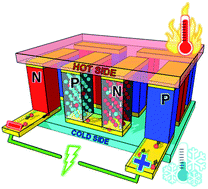Suppressing Ge-vacancies to achieve high single-leg efficiency in GeTe with an ultra-high room temperature power factor†
Abstract
GeTe is among the best medium-temperature thermoelectrics. Its high performance originates from band convergence at the phase transition and low lattice thermal conductivity due to Peierls distortion. In most studies, the peak performance (zT) in GeTe is achieved by designing and optimizing its electronic and thermal transport properties near its phase transition temperature (700 K). However, for efficient power harvesting, a high average zT (zTave) across a wide temperature range is desirable. This calls for a holistic performance evaluation and enhancement not only near 700 K, but also at room temperature. In this work, we leveraged on the confluence of performance enhancement strategies via Cu2Te alloying and In resonant doping to achieve a record-high room temperature power factor of 2800 μW mK−2, and an average power factor of 3700 μW mK−2 between 323 and 773 K. The magnitude of the room temperature power factor is comparable to that of the state-of-the-art Bi2Te3 based compounds. In the optimized sample with Bi doping, a room temperature zT of 0.5 is achieved, highest for lead-free GeTe. Ultimately, a high peak zT of 2.1 at 723 K and single leg power conversion efficiency of 11.8% were achieved between 323 and 745 K, which are among the highest reported for lead-free GeTe.

- This article is part of the themed collection: 2021 Journal of Materials Chemistry A most popular articles


 Please wait while we load your content...
Please wait while we load your content...